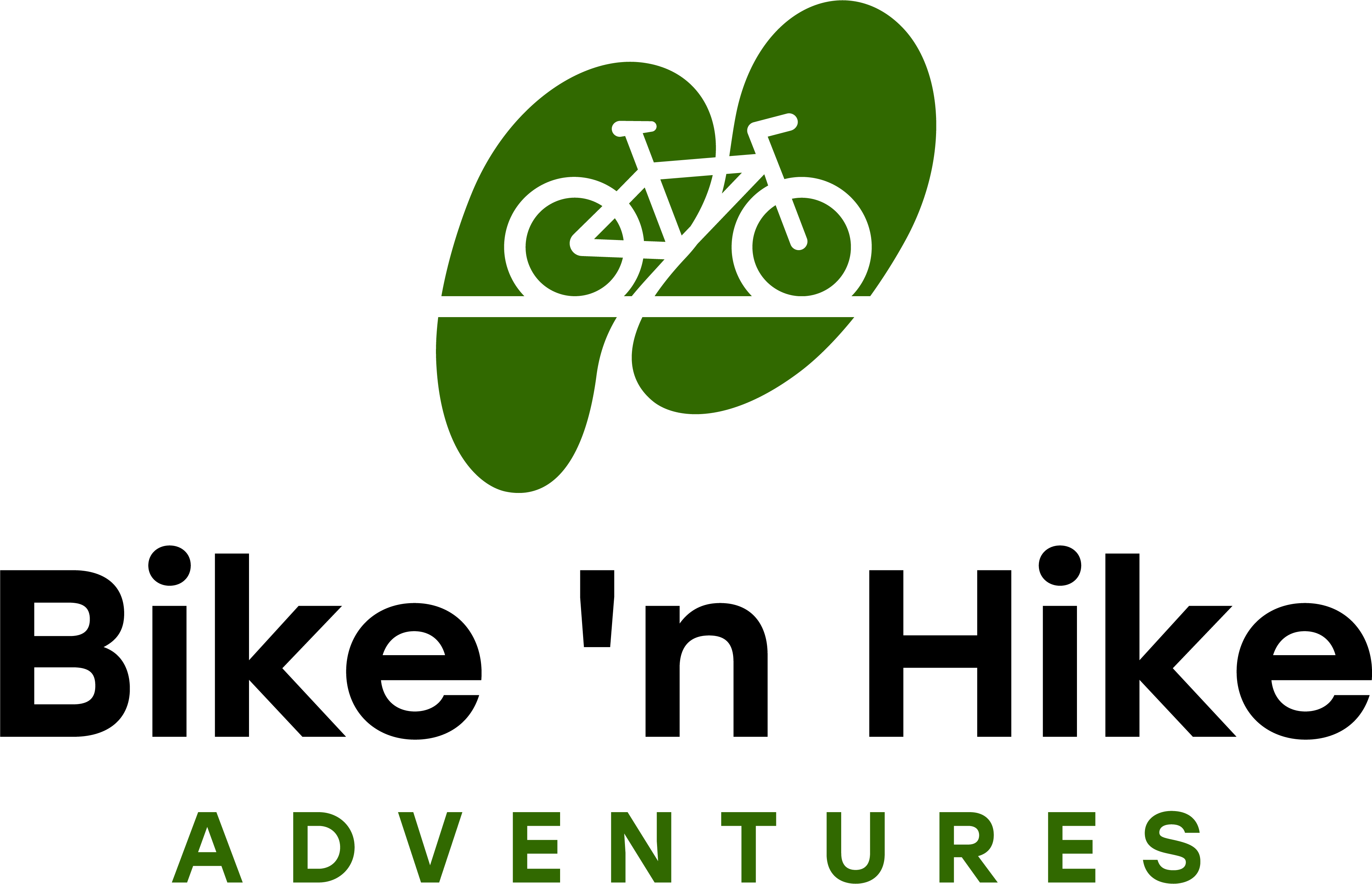
Hiking in Patagonia
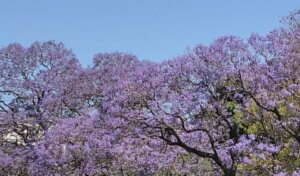
Jacaranda trees in Buenos Aires
THE BOTTOM OF THE WORLD
Our hiking adventure started further south – we still had a 3 ½ hour flight to the bottom of the continent, Ushuaia, from where you can send special postcards from “The End of the World Post Office”. Ushuaia is the gateway to Antarctica and home to the Tierra del Fuego National Park, where we started our outdoor hiking adventure. Our local guide led us on a series of short hikes in the park, explaining the history and telling some interesting stories. The one that resonated most with me was what he told us about beavers, 20 of which were brought in from Canada in 1946 with the hopes of establishing a fur trade. Unfortunately, since the beaver had no natural predator in South America, they grew and multiplied – resulting in thousands of gigantic beavers that now pose an ongoing threat to the natural landscape. I guess they didn’t do a risk assessment….
Softly bearded lenga trees
LEGENDARY PATAGONIA WINDS
Our next hiking day was a lesson in the “variable” Patagonia weather conditions that we had been warned about. Expecting rain, we woke up to a beautiful sunny day. As we awaited our bus taking us to the trail head, it was pouring rain. Then, it started to snow. However by the time we reached the trail head it was beautiful sunshine again! This is all within an hour or so. Today’s destination was Ushuaia Summit, aka Del Medio Mountain, which starts among the lenga trees at a fairly low 200M (650 ft) of elevation. We hiked up to the tree line, where it was cooler and cloudier, and as we reached the summit we were in a raging blizzard. I was so grateful that we were with local guides, as they assured us this was all perfectly normal. At the summit, we also experienced the legendary Patagonia winds. At one point I bent down to pick up someone’s dropped glove, and I couldn’t get up! The winds come simultaneously from all directions and would not allow me to move. We had been warned, but until you are motionless in the grip of a wind gust it is really hard to imagine how it feels. During the less windy interludes, we made our way back down, arriving once again to brilliant sunshine – t-shirts only. What an experience – 4 seasons in a 15K (9M) trek and we were back mid-afternoon. Enough time to explore some local trails close to the hotel and enjoy the long day, seeing the sunset around 10 pm.
Wind warning – in case you weren’t sure it was windy 😊
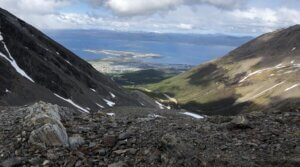
Beagle Channel from the Martial Glacier
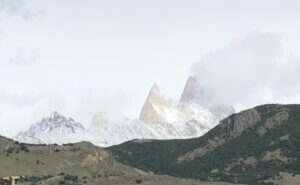
Fitz Roy on a cloudy day
HIKING ON A GLACIER
I am so grateful that I had the opportunity to visit glaciers before they are gone. Southern Patagonia’s ice field includes over 200 glaciers, with at least 47 of them in Los Glaciares National Park, a UNESCO World Heritage property. Our guide told us that glaciers in the area are receding by 500M per year (1640ft). The Perito Morino glacier is famous because it is a live glacier, accumulating mass at a rate similar to that of its loss. Walking on the glacier was certainly a highlight for me. If you want to trek on the glacier, you must do it with approved guides, which is a good thing as there is no wayfinding on the glacier. There are lots of ups and downs, no clear pathways, and steep drops into water. It feels like you are walking on ice cubes. As we walked we heard loud booms as chunks of the glacier broke off. When the sun came out it was so bright you were blinded and couldn’t see anything in the camera lens. The ice is very sharp, which I learned the hard way as I cut my hand in a crevice when I reached in to get a drink of water. Wow – drinking water from something that is millions of years old. It is undoubtedly one of the more interesting hikes I have ever done.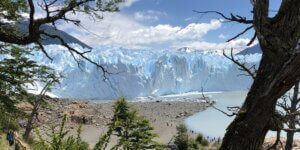
What strikes you most about the glacier is its size. This is one of my favourite photos, showing the scale of people to glacier, and glacier to mountains in the background.

Glaciers are also very colourful and are full of interesting shapes
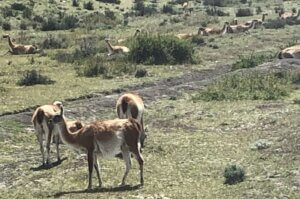
Guanacos
PUMA!!
The next day we were leaving, and it was the most beautiful day – absolutely no wind. It was like Torres del Paine was bidding us “adios” and showing off her beauty. And to top it off, on our way to the airport we saw a PUMA! Wow – our trip was complete. My fondest memory of this major event was of our local bus driver, who was as excited as we all were. He yelled “puma” loudest and immediately backed up the bus so that we could all see. He wanted pictures too! Such an amazing, shared experience, and a perfect story-book ending to an outstanding trip.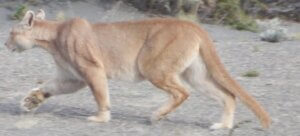
Puma!
3 highlights:
- Our amazing Chilean guides who trekked with us and were so sharing with stories about themselves and their country
- Walking on a glacier, and thinking about how old these ice crystals are, and how beautiful a glacier can be
- The new experience of being immoveable in the Patagonia wind
3 things for the next time:
- See more of the Patagonia region – it is huge and I learned that I have only seen a small part of it
- Do a tour that includes a visit with penguins near Ushuaia
- Travel from Argentina to Chile via the Andean Lakes – a one-day journey, done as a series of lake crossings, that is reportedly spectacular
I had the good fortune to be able to do a lot of hiking in Yukon in 2020. I am sure that year is stuck in your brain as it is in mine – that was Year 1 of Covid.
Late in 2019 I had arranged a work contract in Whitehorse, with the intention of staying a few months and exploring Canada’s north for the first time. I wanted to go in winter, as I had been told that there was really great cross-county skiing there, which I really enjoy. So I arrived in early February, eager to start working and ready for some adventure.
I had signed up to volunteer at Canada’s Winter Games, and I had signed up for a ski event called the Buckwheat International Ski Classic, held annually in Log Cabin, BC. I was ready to embrace the north, notwithstanding the -50C (-58F) temperatures of late January that year.
Sadly, Covid entered all our lives. The Games were shut down, the borders were closed, and everyone was afraid and worried.
However, I was lucky. I had a job, and I was in the safest place in Canada, where social distancing was a way of life.
Yukon is incredible. One of Canada’s territories, it is a vast and pristine area renowned for its breathtaking and rugged natural beauty. Over 80% of its landmass remains untouched and unspoiled, and untamed landscapes stretch as far as the eye can see. Yes, lots of social distancing is possible.
So when I learned that I would be in Yukon for a while, I arranged to have some of my hiking gear shipped to me. While organized group activities were not allowed, people still wanted to get out to enjoy the natural environment and the better weather. What I learned was that people used a Facebook site to arrange outings. Great! I did not want to hike in Yukon on my own. This was bear county, there are cougars, mountain sheep, and lots of other wildlife. I was a city girl from the south and didn’t have enough training, and moreover the trails are not always obvious or well-marked. I was so happy that I found a way to explore with people who were experienced and knowledgeable.
Each week I eagerly perused the FB site to find out where people were going next. I was able to experience so many different hikes, meeting new people each time, and going with some regulars as well. Yukon is very welcoming – all you had to do was say “I want to come” and you had some people to go out with. There were local hikes (within an hour of Whitehorse) and some that were further away too. It was also easy to arrange a ride if you didn’t have a car.
View from the Sam McGee trail, one of my (many) favourites
Yukon is such an interesting place, owing most of its fame to the short period of the Klondike Gold Rush from about 1896-1899. During this time, thousands of people from all over the world braved the hazardous Yukon River (and the infamous White Horse Rapids at Miles Canyon) and other challenges to seek their fortune near Dawson City. The Gold Rush pretty much ended by the early 1900’s as by that time the easily accessible gold deposits were exhausted. That’s not a long time. This massive influx of people required transportation, equipment and supplies to support them, leading to an economic boom in the territory. The Gold Rush played a crucial role in the territory’s historical and cultural identity. You can hike the Chilkoot Trail to get a taste of what these prospectors endured, minus the 12 months supplies they were supposed to bring with them as they headed to Dawson City.
Miles Canyon was one of my favourite places to visit – it was close to where I lived and a great place for hiking, at any time. It is calm and beautiful now, but was a significant obstacle for prospectors traveling by boat to reach the goldfields. There is a wonderful painting of what the rapids looked like to them at the MacBride Museum in Whitehorse.
Miles Canyon in the spring/summer

Miles Canyon in the fall – lots of yellow

Miles Canyon in the winter
Yukon is also a place of surprises, at least for me. I expected it to be really cold all of the time. Yes, there were a few frigid days in the winter, but often the temperature hovered around -5 degrees C (41F). During an August trip to the Arctic Circle, I was struck by the profusion of wildflowers. I did not expect anything like that in Yukon.


Wildflowers growing near the Arctic Circle
As the year went on and it was clear that Covid would not be over soon, people came to visit me. It was possible, you just had to follow the entry rules. Hooray – more people to hike with. And, we could go further too.
New destinations opened up for me – Dawson City, Tombstone Territorial Park, Haines Junction and the magnificent Kluane National Park.
Rainbow during a rainy hike to King’s Throne, Haines Junction

Short diversion to Five Finger Rapids along the way to Dawson City

View along the Grizzly Ridge, Tombstone

Oh wow – I can’t believe we saw 2 moose in Two Moose Lake, Tombstone!
All of Yukon is breathtaking. When you are driving, you can round a bend and be rewarded with another spectacular lake. You can’t pass a vista such as Emerald Lake, famous for its vibrant blue-green water, and not stop to stare and appreciate the beauty. There are mountains to ascend, including Canada’s highest peak, Mount Logan. The mighty Yukon River, one of the longest in North America, flows through the territory, a stunning waterway that offers opportunities for canoeing and kayaking. I took lessons in both! You can’t be in Yukon and ignore the outdoors. In the peak summer months, you can benefit from about 19 hours of daylight,

which just makes you want to do more. You don’t get the intense heat that you might be used to in “the south”, which makes it more comfortable for hiking. In the winter months of course, you have the opposite – only about 5 hours of light. However, it is in these winter months that you have a higher likelihood of seeing the Northern Lights. Unfortunately, I didn’t get to see them, even though I was there for a year and I was diligently checking all my aurora apps.

Emerald Lake, near Carcross
What does this mean? It means that I have to go back! No arm twisting required! So many hikes I did, so many waiting for another visit.
Where else can my feet take me?
I had the wonderful opportunity to hike in Patagonia with a group of friends from my hiking club. For me, two new countries that I am so grateful that I was able to see – Argentina and Chile.
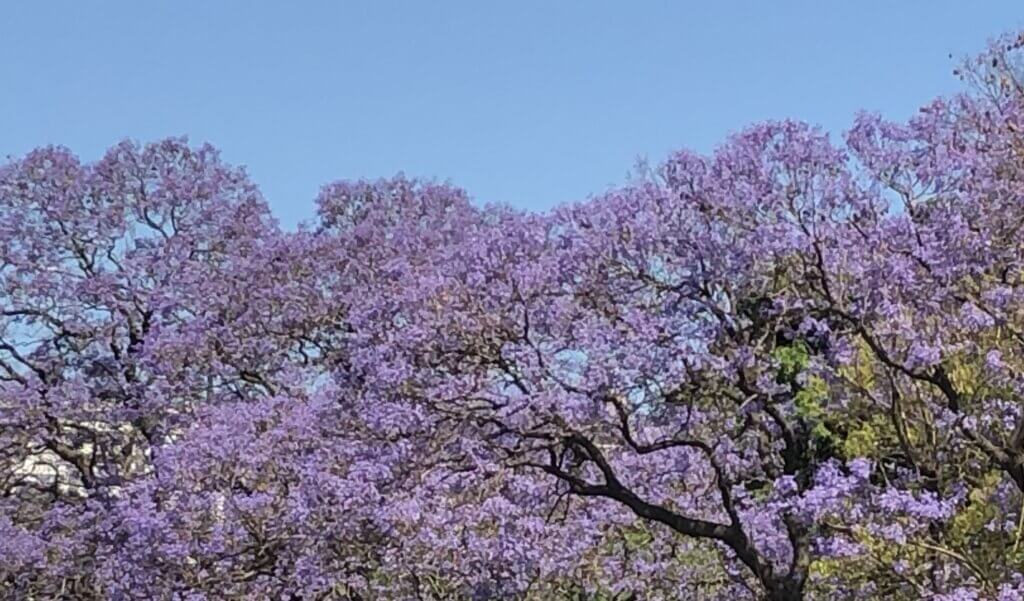
Jacaranda trees in Buenos Aires
We left mid-November when the weather at home was leaning towards shorter, darker, colder, and arrived to a warm, colourful spring in Buenos Aires. The jacaranda trees, which don’t grow in my southern Ontario climate, were so delightful to see, with mature trees in full bloom everywhere it seemed.
THE BOTTOM OF THE WORLD
Our hiking adventure started further south – we still had a 3 ½ hour flight to the bottom of the continent, Ushuaia, from where you can send special postcards from “The End of the World Post Office”. Ushuaia is the gateway to Antarctica and home to the Tierra del Fuego National Park, where we started our outdoor hiking adventure. Our local guide led us on a series of short hikes in the park, explaining the history and telling some interesting stories. The one that resonated most with me was what he told us about beavers, 20 of which were brought in from Canada in 1946 with the hopes of establishing a fur trade. Unfortunately, since the beaver had no natural predator in South America, they grew and multiplied – resulting in thousands of gigantic beavers that now pose an ongoing threat to the natural landscape. I guess they didn’t do a risk assessment. We were also introduced to the bearded lenga trees, which grow in abundance in this part of the world, but not really in other colder, snowy climates.

LEGENDARY PATAGONIA WINDS
Our next hiking day was a lesson in the “variable” Patagonia weather conditions that we had been warned about. Expecting rain, we woke up to a beautiful sunny day. As we awaited our bus taking us to the trail head, it was pouring rain. Then, it started to snow. However by the time we reached the trail head it was beautiful sunshine again! This is all within an hour or so. Today’s destination was Ushuaia Summit, aka Del Medio Mountain, which starts among the
Softly bearded lenga trees
lenga trees at a fairly low 200M (650 ft) of elevation. We hiked up to the tree line, where it was cooler and cloudier, and as we reached the summit we were in a raging blizzard. I was so grateful that we were with local guides, as they assured us this was all perfectly normal. At the summit, we also experienced the legendary Patagonia winds. At one point I bent down to pick up someone’s dropped glove, and I couldn’t get up! The winds come simultaneously from all directions and would not allow me to move. We had been warned, but until you are motionless in the grip of a wind gust it is really hard to imagine how it feels. During the less windy interludes, we made our way back down, arriving once again to brilliant sunshine – t-shirts only. What an experience – 4 seasons in a 15K (9M) trek and we were back mid-afternoon. Enough time to explore some local trails close to the hotel and enjoy the long day, seeing the sunset around 10 pm.
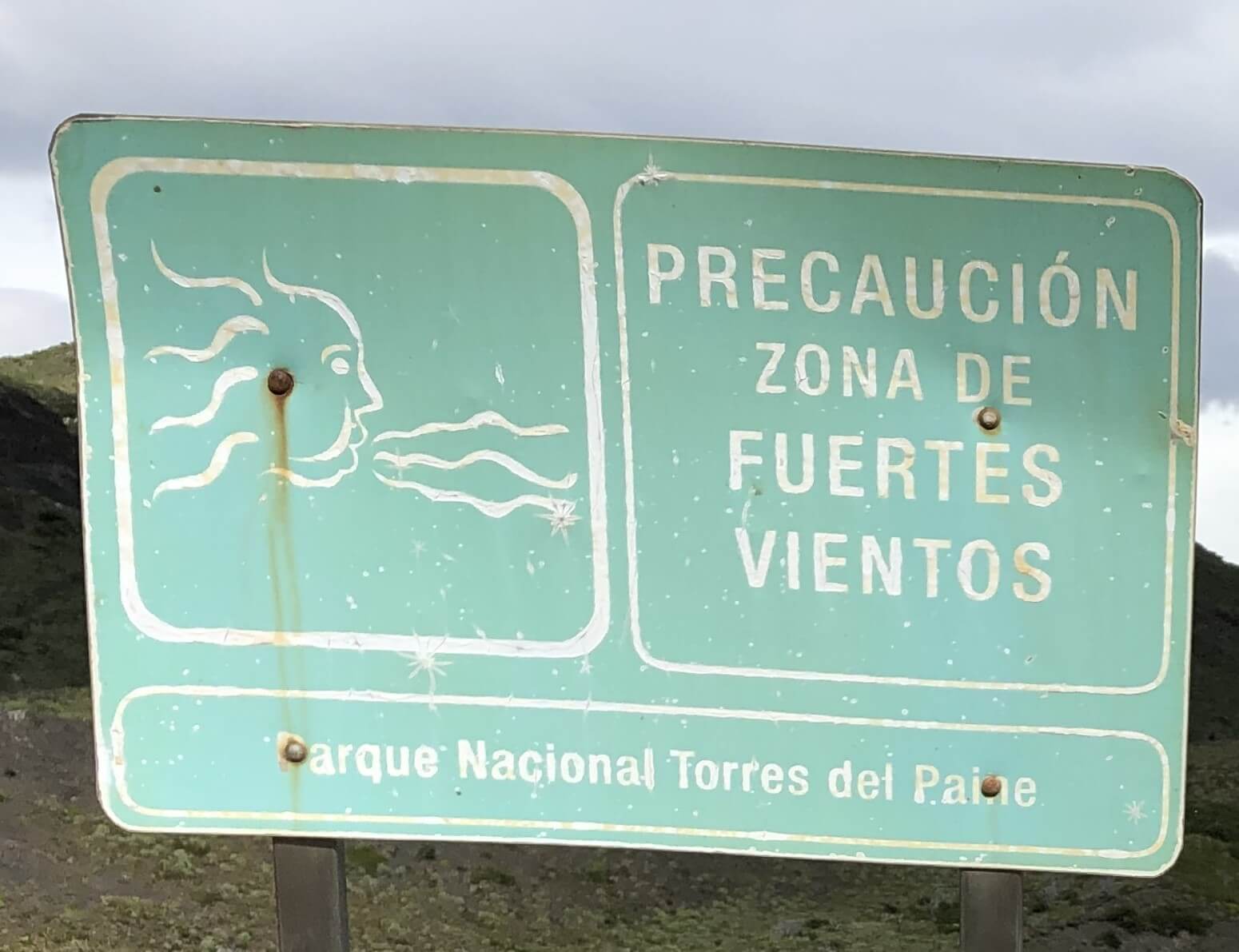
Wind warning – in case you weren’t sure it was windy
We later boarded a plan to take us to El Calafate, and then a bus to El Chaltén, with a goal of seeing Mount Fitz Roy. Climbing Fitz Roy is best left to mountaineers, we hikers were happy to be in the area, described as the National Capital of Trekking in Argentina, with a planned hike to Mirador Capri. On a sunny day, we would have been rewarded with panoramic views of the Rio de las Vueltas and the impressive Mount Fitz Roy, a famous destination and recognizable landscape. Unfortunately – it was not a sunny day and our views were completely obstructed by clouds and a very un-variable rainy
day. We completed our Laguna Capri trek which did have some really nice trails and viewpoints, regularly experiencing more of the famous Patagonia winds along the way. The lagoon is located in a beautiful, forested area with lots of varied local fauna.
The following day’s hike was to the Martial Glacier, a 20,000-year-old glacier offering panoramic views of the bottom of the world. Total ascent today was only 400M (1,300 ft) and 8KMs (5M), but it took longer than yesterday – today was steeper. Still, lots of smiling faces at the top!
Beagle Channel from the Martial Glacier
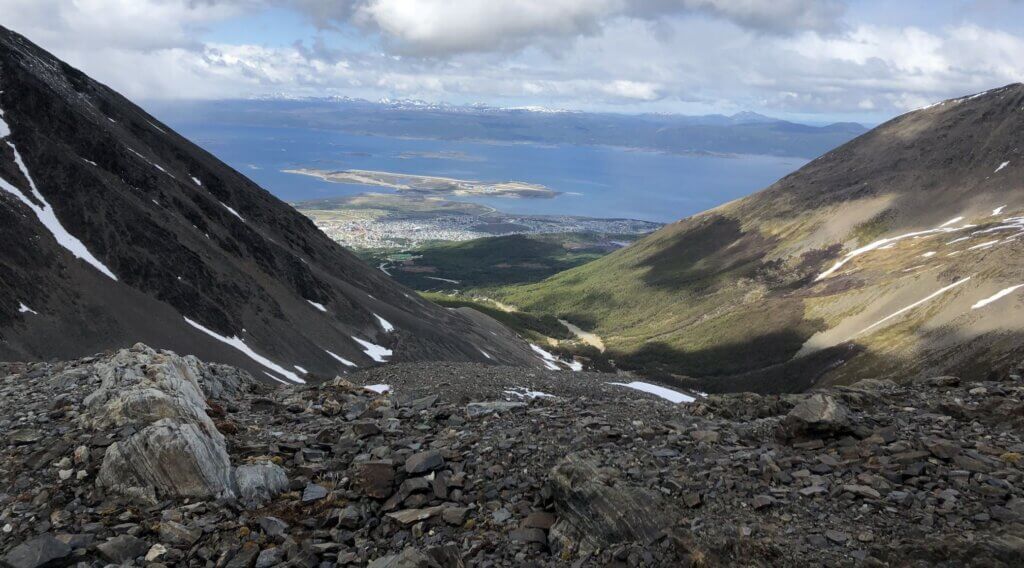
The following day was less cloudy and we were at least able to take pictures of what we missed – but we had to move on. Back to El Calafate, our next hike was the Perito Moreno Glacier in the Glacier National Park.
Fitz Roy on a cloudy day
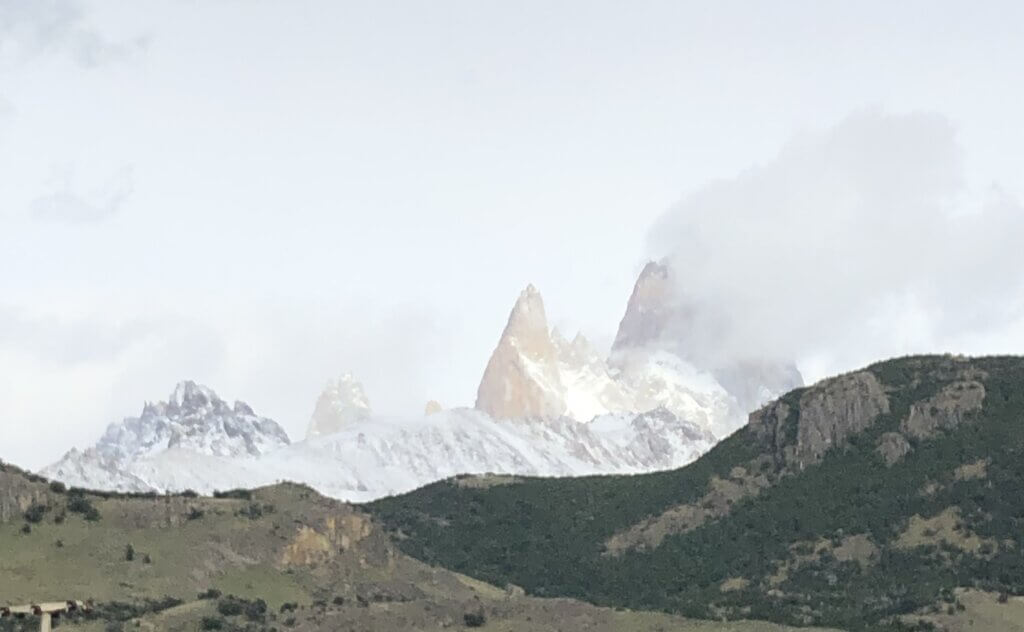
HIKING ON A GLACIER
I am so grateful that I had the opportunity to visit glaciers before they are gone. Southern Patagonia’s ice field includes over 200 glaciers, with at least 47 of them in Los Glaciares National Park, a UNESCO World Heritage property. Our guide told us that glaciers in the area are receding by 500M per year (1640ft).
The Perito Morino glacier is famous because it is a live glacier, accumulating mass at a rate similar to that of its loss. Walking on the glacier was certainly a highlight for me. If you want to trek on the glacier, you must do it with approved guides, which is a good thing as there is no wayfinding on the glacier. There are lots of ups and downs, no clear pathways, and steep drops into water. It feels like you are walking on ice cubes. As we walked we heard loud booms as chunks of the glacier broke off. When the sun came out it was so bright you were blinded and couldn’t see anything in the camera lens. The ice is very sharp, which I learned the hard way as I cut my hand in a crevice when I reached in to get a drink of water. Wow – drinking water from something that is millions of years old. It is undoubtedly one of the more interesting hikes I have ever done.

What strikes you most about the glacier is its size. This is one of my favourite photos, showing the scale of people to glacier, and glacier to mountains in the background.
Glaciers are also very colourful and are full of interesting shapes
A stop at the Glaciarium Patagonian Ice Museum in El Calafate was a wonderful complement to visiting the glacier, offering scientific and technological information in a visual way that made you think deeply about global warming and the impacts to the natural environment.
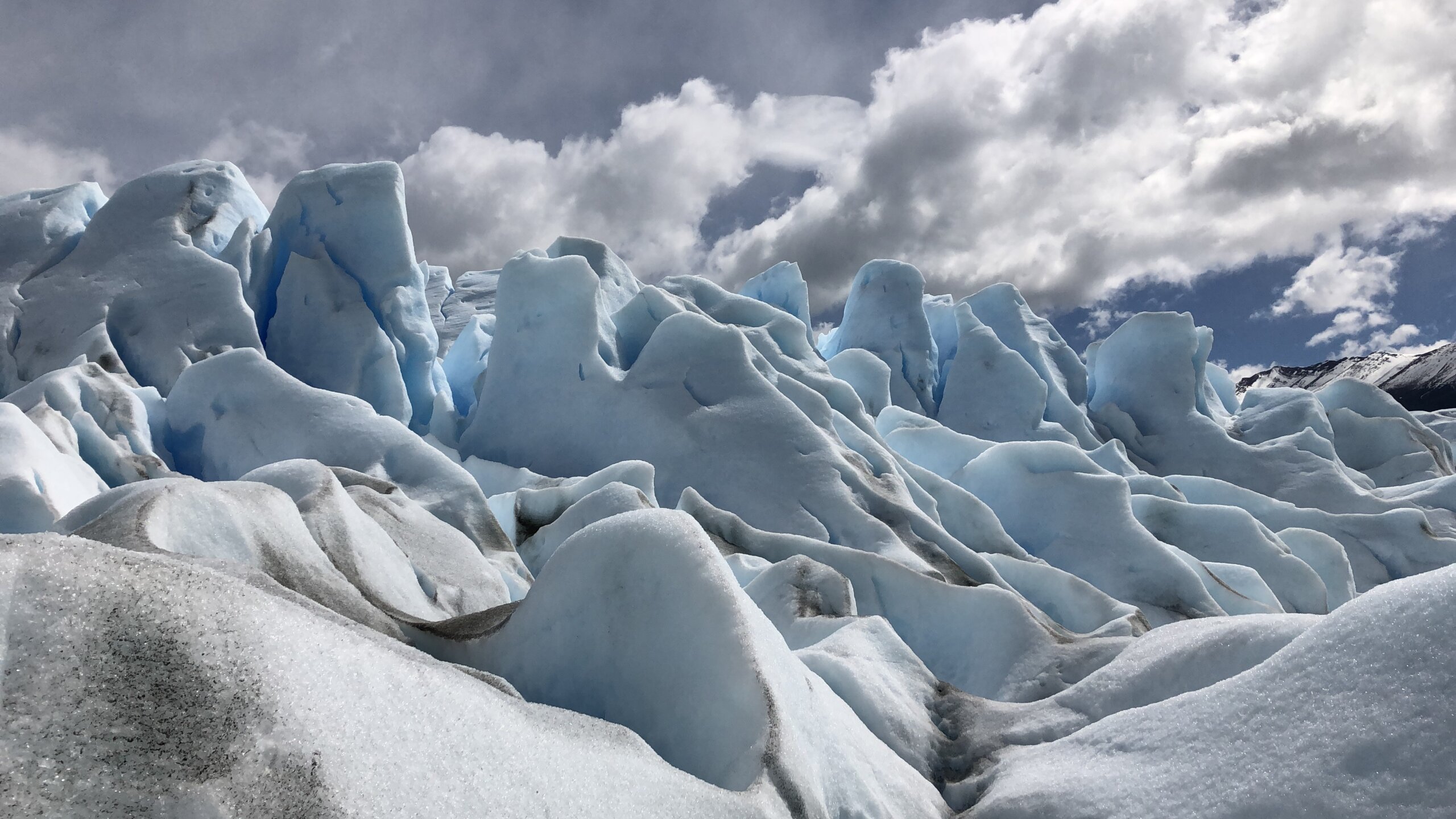

Guanacos
Completing the Argentinian leg of our trip, we were now headed to the Torres del Paine National Park in Chile, known for soaring mountains, golden grasslands and unique wildlife such as llama-like guanacos and condors, the largest flying birds in South America. We were advised that a big treat would be to see a puma.
We did one day of bus touring enabling us to see more of the park. We saw a lot that day, including Puente Negro (Black Bridge), Nordenskjöld Lookout, Sarmiento Lookout, Lake Pehoé and Salto Grande waterfall. We also had a lake cruise to Grey Glacier. For sure, we would not have covered that amount of territory by foot, however we barely had time to do more than take pictures. It is breathtaking no matter where you look. We had a short 6KM hike to some caves said to have drawings that are 4000-6000 years old (the Pinturas Rupestre). Fascinating to see, but tempered by the comment from the guide that some (knowledgeable) people think they are fake.
The next day we had a choice between hiking to one of the National’s Park’s most striking viewpoints, or a trek that included the Laguna Verde (Green Lagoon), the Laguna Honda (Deep Lagoon) and climbing to a summit with a 360° view of the Paine Massif in the north, and Lago Toro (the largest lake in the region).
I wanted to do both, but selected the first hike going to the top of Cerro Paine (Paine hill), along a scenic portion of the Ascencio Valley. Some of our group were riding horses up, but I don’t ride. No regrets on choice – the view was truly astounding. We had a panoramic view of the Torres (the three famous granite towers), the Paine River Valley and Laguna Azul, and lakes Nordenskjöld and Sarmiento. A wonderful mix of granite peaks, glaciers, lakes, forest and Patagonian pampas all at once! And, lots of stories in the evening listening to the tales of the riders. What a fantastic day for everyone.
On our last hike, we explored the Laguna Verde and the Ascencio Valley. This part of the park was busier as there are a lot of people who come in for the day only, choosing this location because it is not as challenging. I guess they were on a tight schedule as many seemed to be almost running to get to the end, perhaps without really appreciating the journey. I was so grateful to be travelling with the group from my club – together we experienced some incredible wonders of Patagonia with a sense of shared awe and accomplishment.
PUMA!!
The next day we were leaving, and it was the most beautiful day – absolutely no wind. It was like Torres del Paine was bidding us “adios” and showing off her beauty.
And to top it off, on our way to the airport we saw a PUMA! Wow – our trip was complete. My fondest memory of this major event was of our local bus driver, who was as excited as we all were. He yelled “puma” loudest and immediately backed up the bus so that we could all see. He wanted pictures too! Such an amazing, shared experience, and a perfect story-book ending to an outstanding trip.

Where else can my feet take me?
Where would you like to go?
Maybe we could go together?
3 highlights:
- Our amazing Chilean guides who trekked with us and were so sharing with stories about themselves and their country
- Walking on a glacier, and thinking about how old these ice crystals are, and how beautiful a glacier can be
- The new experience of being immoveable in the Patagonia wind
3 things for the next time:
- See more of the Patagonia region – it is huge and I learned that I have only seen a small part of it
- Do a tour that includes a visit with penguins near Ushuaia
- Travel from Argentina to Chile via the Andean Lakes – a one-day journey, done as a series of lake crossings, that is reportedly spectacular
![]()
![]()
![]()
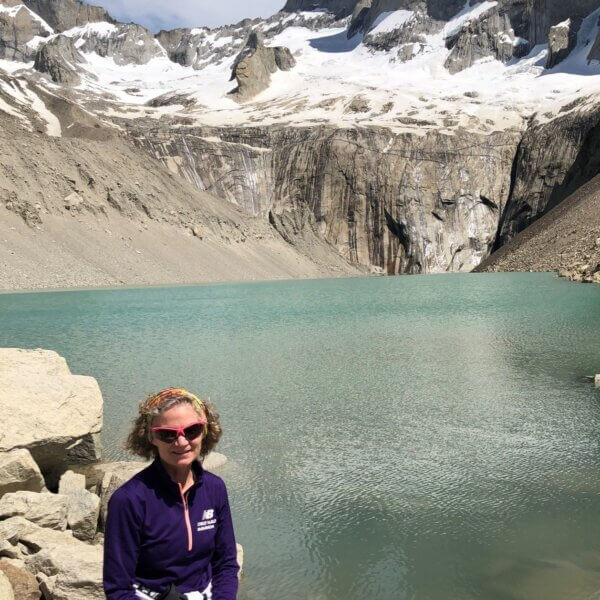
Recent Posts
Cycling Lake Constance
Art in Nature
Remember When Being Outside Was FUN?
All Categories

Hiking in Patagonia

Jacaranda trees in Buenos Aires
THE BOTTOM OF THE WORLD
Our hiking adventure started further south – we still had a 3 ½ hour flight to the bottom of the continent, Ushuaia, from where you can send special postcards from “The End of the World Post Office”. Ushuaia is the gateway to Antarctica and home to the Tierra del Fuego National Park, where we started our outdoor hiking adventure. Our local guide led us on a series of short hikes in the park, explaining the history and telling some interesting stories. The one that resonated most with me was what he told us about beavers, 20 of which were brought in from Canada in 1946 with the hopes of establishing a fur trade. Unfortunately, since the beaver had no natural predator in South America, they grew and multiplied – resulting in thousands of gigantic beavers that now pose an ongoing threat to the natural landscape. I guess they didn’t do a risk assessment….
Softly bearded lenga trees
LEGENDARY PATAGONIA WINDS
Our next hiking day was a lesson in the “variable” Patagonia weather conditions that we had been warned about. Expecting rain, we woke up to a beautiful sunny day. As we awaited our bus taking us to the trail head, it was pouring rain. Then, it started to snow. However by the time we reached the trail head it was beautiful sunshine again! This is all within an hour or so. Today’s destination was Ushuaia Summit, aka Del Medio Mountain, which starts among the lenga trees at a fairly low 200M (650 ft) of elevation. We hiked up to the tree line, where it was cooler and cloudier, and as we reached the summit we were in a raging blizzard. I was so grateful that we were with local guides, as they assured us this was all perfectly normal. At the summit, we also experienced the legendary Patagonia winds. At one point I bent down to pick up someone’s dropped glove, and I couldn’t get up! The winds come simultaneously from all directions and would not allow me to move. We had been warned, but until you are motionless in the grip of a wind gust it is really hard to imagine how it feels. During the less windy interludes, we made our way back down, arriving once again to brilliant sunshine – t-shirts only. What an experience – 4 seasons in a 15K (9M) trek and we were back mid-afternoon. Enough time to explore some local trails close to the hotel and enjoy the long day, seeing the sunset around 10 pm.
Wind warning – in case you weren’t sure it was windy 😊

Beagle Channel from the Martial Glacier

Fitz Roy on a cloudy day
HIKING ON A GLACIER
I am so grateful that I had the opportunity to visit glaciers before they are gone. Southern Patagonia’s ice field includes over 200 glaciers, with at least 47 of them in Los Glaciares National Park, a UNESCO World Heritage property. Our guide told us that glaciers in the area are receding by 500M per year (1640ft). The Perito Morino glacier is famous because it is a live glacier, accumulating mass at a rate similar to that of its loss. Walking on the glacier was certainly a highlight for me. If you want to trek on the glacier, you must do it with approved guides, which is a good thing as there is no wayfinding on the glacier. There are lots of ups and downs, no clear pathways, and steep drops into water. It feels like you are walking on ice cubes. As we walked we heard loud booms as chunks of the glacier broke off. When the sun came out it was so bright you were blinded and couldn’t see anything in the camera lens. The ice is very sharp, which I learned the hard way as I cut my hand in a crevice when I reached in to get a drink of water. Wow – drinking water from something that is millions of years old. It is undoubtedly one of the more interesting hikes I have ever done.
What strikes you most about the glacier is its size. This is one of my favourite photos, showing the scale of people to glacier, and glacier to mountains in the background.

Glaciers are also very colourful and are full of interesting shapes

Guanacos
PUMA!!
The next day we were leaving, and it was the most beautiful day – absolutely no wind. It was like Torres del Paine was bidding us “adios” and showing off her beauty. And to top it off, on our way to the airport we saw a PUMA! Wow – our trip was complete. My fondest memory of this major event was of our local bus driver, who was as excited as we all were. He yelled “puma” loudest and immediately backed up the bus so that we could all see. He wanted pictures too! Such an amazing, shared experience, and a perfect story-book ending to an outstanding trip.
Puma!
3 highlights:
- Our amazing Chilean guides who trekked with us and were so sharing with stories about themselves and their country
- Walking on a glacier, and thinking about how old these ice crystals are, and how beautiful a glacier can be
- The new experience of being immoveable in the Patagonia wind
3 things for the next time:
- See more of the Patagonia region – it is huge and I learned that I have only seen a small part of it
- Do a tour that includes a visit with penguins near Ushuaia
- Travel from Argentina to Chile via the Andean Lakes – a one-day journey, done as a series of lake crossings, that is reportedly spectacular
I had the good fortune to be able to do a lot of hiking in Yukon in 2020. I am sure that year is stuck in your brain as it is in mine – that was Year 1 of Covid.
Late in 2019 I had arranged a work contract in Whitehorse, with the intention of staying a few months and exploring Canada’s north for the first time. I wanted to go in winter, as I had been told that there was really great cross-county skiing there, which I really enjoy. So I arrived in early February, eager to start working and ready for some adventure.
I had signed up to volunteer at Canada’s Winter Games, and I had signed up for a ski event called the Buckwheat International Ski Classic, held annually in Log Cabin, BC. I was ready to embrace the north, notwithstanding the -50C (-58F) temperatures of late January that year.
Sadly, Covid entered all our lives. The Games were shut down, the borders were closed, and everyone was afraid and worried.
However, I was lucky. I had a job, and I was in the safest place in Canada, where social distancing was a way of life.
Yukon is incredible. One of Canada’s territories, it is a vast and pristine area renowned for its breathtaking and rugged natural beauty. Over 80% of its landmass remains untouched and unspoiled, and untamed landscapes stretch as far as the eye can see. Yes, lots of social distancing is possible.
So when I learned that I would be in Yukon for a while, I arranged to have some of my hiking gear shipped to me. While organized group activities were not allowed, people still wanted to get out to enjoy the natural environment and the better weather. What I learned was that people used a Facebook site to arrange outings. Great! I did not want to hike in Yukon on my own. This was bear county, there are cougars, mountain sheep, and lots of other wildlife. I was a city girl from the south and didn’t have enough training, and moreover the trails are not always obvious or well-marked. I was so happy that I found a way to explore with people who were experienced and knowledgeable.
Each week I eagerly perused the FB site to find out where people were going next. I was able to experience so many different hikes, meeting new people each time, and going with some regulars as well. Yukon is very welcoming – all you had to do was say “I want to come” and you had some people to go out with. There were local hikes (within an hour of Whitehorse) and some that were further away too. It was also easy to arrange a ride if you didn’t have a car.
View from the Sam McGee trail, one of my (many) favourites
Yukon is such an interesting place, owing most of its fame to the short period of the Klondike Gold Rush from about 1896-1899. During this time, thousands of people from all over the world braved the hazardous Yukon River (and the infamous White Horse Rapids at Miles Canyon) and other challenges to seek their fortune near Dawson City. The Gold Rush pretty much ended by the early 1900’s as by that time the easily accessible gold deposits were exhausted. That’s not a long time. This massive influx of people required transportation, equipment and supplies to support them, leading to an economic boom in the territory. The Gold Rush played a crucial role in the territory’s historical and cultural identity. You can hike the Chilkoot Trail to get a taste of what these prospectors endured, minus the 12 months supplies they were supposed to bring with them as they headed to Dawson City.
Miles Canyon was one of my favourite places to visit – it was close to where I lived and a great place for hiking, at any time. It is calm and beautiful now, but was a significant obstacle for prospectors traveling by boat to reach the goldfields. There is a wonderful painting of what the rapids looked like to them at the MacBride Museum in Whitehorse.
Miles Canyon in the spring/summer

Miles Canyon in the fall – lots of yellow

Miles Canyon in the winter
Yukon is also a place of surprises, at least for me. I expected it to be really cold all of the time. Yes, there were a few frigid days in the winter, but often the temperature hovered around -5 degrees C (41F). During an August trip to the Arctic Circle, I was struck by the profusion of wildflowers. I did not expect anything like that in Yukon.


Wildflowers growing near the Arctic Circle
As the year went on and it was clear that Covid would not be over soon, people came to visit me. It was possible, you just had to follow the entry rules. Hooray – more people to hike with. And, we could go further too.
New destinations opened up for me – Dawson City, Tombstone Territorial Park, Haines Junction and the magnificent Kluane National Park.
Rainbow during a rainy hike to King’s Throne, Haines Junction

Short diversion to Five Finger Rapids along the way to Dawson City

View along the Grizzly Ridge, Tombstone

Oh wow – I can’t believe we saw 2 moose in Two Moose Lake, Tombstone!
All of Yukon is breathtaking. When you are driving, you can round a bend and be rewarded with another spectacular lake. You can’t pass a vista such as Emerald Lake, famous for its vibrant blue-green water, and not stop to stare and appreciate the beauty. There are mountains to ascend, including Canada’s highest peak, Mount Logan. The mighty Yukon River, one of the longest in North America, flows through the territory, a stunning waterway that offers opportunities for canoeing and kayaking. I took lessons in both! You can’t be in Yukon and ignore the outdoors. In the peak summer months, you can benefit from about 19 hours of daylight,

which just makes you want to do more. You don’t get the intense heat that you might be used to in “the south”, which makes it more comfortable for hiking. In the winter months of course, you have the opposite – only about 5 hours of light. However, it is in these winter months that you have a higher likelihood of seeing the Northern Lights. Unfortunately, I didn’t get to see them, even though I was there for a year and I was diligently checking all my aurora apps.

Emerald Lake, near Carcross
What does this mean? It means that I have to go back! No arm twisting required! So many hikes I did, so many waiting for another visit.
Where else can my feet take me?
I had the wonderful opportunity to hike in Patagonia with a group of friends from my hiking club. For me, two new countries that I am so grateful that I was able to see – Argentina and Chile.

Jacaranda trees in Buenos Aires
We left mid-November when the weather at home was leaning towards shorter, darker, colder, and arrived to a warm, colourful spring in Buenos Aires. The jacaranda trees, which don’t grow in my southern Ontario climate, were so delightful to see, with mature trees in full bloom everywhere it seemed.
THE BOTTOM OF THE WORLD
Our hiking adventure started further south – we still had a 3 ½ hour flight to the bottom of the continent, Ushuaia, from where you can send special postcards from “The End of the World Post Office”. Ushuaia is the gateway to Antarctica and home to the Tierra del Fuego National Park, where we started our outdoor hiking adventure. Our local guide led us on a series of short hikes in the park, explaining the history and telling some interesting stories. The one that resonated most with me was what he told us about beavers, 20 of which were brought in from Canada in 1946 with the hopes of establishing a fur trade. Unfortunately, since the beaver had no natural predator in South America, they grew and multiplied – resulting in thousands of gigantic beavers that now pose an ongoing threat to the natural landscape. I guess they didn’t do a risk assessment. We were also introduced to the bearded lenga trees, which grow in abundance in this part of the world, but not really in other colder, snowy climates.

LEGENDARY PATAGONIA WINDS
Our next hiking day was a lesson in the “variable” Patagonia weather conditions that we had been warned about. Expecting rain, we woke up to a beautiful sunny day. As we awaited our bus taking us to the trail head, it was pouring rain. Then, it started to snow. However by the time we reached the trail head it was beautiful sunshine again! This is all within an hour or so. Today’s destination was Ushuaia Summit, aka Del Medio Mountain, which starts among the
Softly bearded lenga trees
lenga trees at a fairly low 200M (650 ft) of elevation. We hiked up to the tree line, where it was cooler and cloudier, and as we reached the summit we were in a raging blizzard. I was so grateful that we were with local guides, as they assured us this was all perfectly normal. At the summit, we also experienced the legendary Patagonia winds. At one point I bent down to pick up someone’s dropped glove, and I couldn’t get up! The winds come simultaneously from all directions and would not allow me to move. We had been warned, but until you are motionless in the grip of a wind gust it is really hard to imagine how it feels. During the less windy interludes, we made our way back down, arriving once again to brilliant sunshine – t-shirts only. What an experience – 4 seasons in a 15K (9M) trek and we were back mid-afternoon. Enough time to explore some local trails close to the hotel and enjoy the long day, seeing the sunset around 10 pm.

Wind warning – in case you weren’t sure it was windy
We later boarded a plan to take us to El Calafate, and then a bus to El Chaltén, with a goal of seeing Mount Fitz Roy. Climbing Fitz Roy is best left to mountaineers, we hikers were happy to be in the area, described as the National Capital of Trekking in Argentina, with a planned hike to Mirador Capri. On a sunny day, we would have been rewarded with panoramic views of the Rio de las Vueltas and the impressive Mount Fitz Roy, a famous destination and recognizable landscape. Unfortunately – it was not a sunny day and our views were completely obstructed by clouds and a very un-variable rainy
day. We completed our Laguna Capri trek which did have some really nice trails and viewpoints, regularly experiencing more of the famous Patagonia winds along the way. The lagoon is located in a beautiful, forested area with lots of varied local fauna.
The following day’s hike was to the Martial Glacier, a 20,000-year-old glacier offering panoramic views of the bottom of the world. Total ascent today was only 400M (1,300 ft) and 8KMs (5M), but it took longer than yesterday – today was steeper. Still, lots of smiling faces at the top!
Beagle Channel from the Martial Glacier

The following day was less cloudy and we were at least able to take pictures of what we missed – but we had to move on. Back to El Calafate, our next hike was the Perito Moreno Glacier in the Glacier National Park.
Fitz Roy on a cloudy day

HIKING ON A GLACIER
I am so grateful that I had the opportunity to visit glaciers before they are gone. Southern Patagonia’s ice field includes over 200 glaciers, with at least 47 of them in Los Glaciares National Park, a UNESCO World Heritage property. Our guide told us that glaciers in the area are receding by 500M per year (1640ft).
The Perito Morino glacier is famous because it is a live glacier, accumulating mass at a rate similar to that of its loss. Walking on the glacier was certainly a highlight for me. If you want to trek on the glacier, you must do it with approved guides, which is a good thing as there is no wayfinding on the glacier. There are lots of ups and downs, no clear pathways, and steep drops into water. It feels like you are walking on ice cubes. As we walked we heard loud booms as chunks of the glacier broke off. When the sun came out it was so bright you were blinded and couldn’t see anything in the camera lens. The ice is very sharp, which I learned the hard way as I cut my hand in a crevice when I reached in to get a drink of water. Wow – drinking water from something that is millions of years old. It is undoubtedly one of the more interesting hikes I have ever done.

What strikes you most about the glacier is its size. This is one of my favourite photos, showing the scale of people to glacier, and glacier to mountains in the background.
Glaciers are also very colourful and are full of interesting shapes
A stop at the Glaciarium Patagonian Ice Museum in El Calafate was a wonderful complement to visiting the glacier, offering scientific and technological information in a visual way that made you think deeply about global warming and the impacts to the natural environment.


Guanacos
Completing the Argentinian leg of our trip, we were now headed to the Torres del Paine National Park in Chile, known for soaring mountains, golden grasslands and unique wildlife such as llama-like guanacos and condors, the largest flying birds in South America. We were advised that a big treat would be to see a puma.
We did one day of bus touring enabling us to see more of the park. We saw a lot that day, including Puente Negro (Black Bridge), Nordenskjöld Lookout, Sarmiento Lookout, Lake Pehoé and Salto Grande waterfall. We also had a lake cruise to Grey Glacier. For sure, we would not have covered that amount of territory by foot, however we barely had time to do more than take pictures. It is breathtaking no matter where you look. We had a short 6KM hike to some caves said to have drawings that are 4000-6000 years old (the Pinturas Rupestre). Fascinating to see, but tempered by the comment from the guide that some (knowledgeable) people think they are fake.
The next day we had a choice between hiking to one of the National’s Park’s most striking viewpoints, or a trek that included the Laguna Verde (Green Lagoon), the Laguna Honda (Deep Lagoon) and climbing to a summit with a 360° view of the Paine Massif in the north, and Lago Toro (the largest lake in the region).
I wanted to do both, but selected the first hike going to the top of Cerro Paine (Paine hill), along a scenic portion of the Ascencio Valley. Some of our group were riding horses up, but I don’t ride. No regrets on choice – the view was truly astounding. We had a panoramic view of the Torres (the three famous granite towers), the Paine River Valley and Laguna Azul, and lakes Nordenskjöld and Sarmiento. A wonderful mix of granite peaks, glaciers, lakes, forest and Patagonian pampas all at once! And, lots of stories in the evening listening to the tales of the riders. What a fantastic day for everyone.
On our last hike, we explored the Laguna Verde and the Ascencio Valley. This part of the park was busier as there are a lot of people who come in for the day only, choosing this location because it is not as challenging. I guess they were on a tight schedule as many seemed to be almost running to get to the end, perhaps without really appreciating the journey. I was so grateful to be travelling with the group from my club – together we experienced some incredible wonders of Patagonia with a sense of shared awe and accomplishment.
PUMA!!
The next day we were leaving, and it was the most beautiful day – absolutely no wind. It was like Torres del Paine was bidding us “adios” and showing off her beauty.
And to top it off, on our way to the airport we saw a PUMA! Wow – our trip was complete. My fondest memory of this major event was of our local bus driver, who was as excited as we all were. He yelled “puma” loudest and immediately backed up the bus so that we could all see. He wanted pictures too! Such an amazing, shared experience, and a perfect story-book ending to an outstanding trip.

Where else can my feet take me?
Where would you like to go?
Maybe we could go together?
3 highlights:
- Our amazing Chilean guides who trekked with us and were so sharing with stories about themselves and their country
- Walking on a glacier, and thinking about how old these ice crystals are, and how beautiful a glacier can be
- The new experience of being immoveable in the Patagonia wind
3 things for the next time:
- See more of the Patagonia region – it is huge and I learned that I have only seen a small part of it
- Do a tour that includes a visit with penguins near Ushuaia
- Travel from Argentina to Chile via the Andean Lakes – a one-day journey, done as a series of lake crossings, that is reportedly spectacular
![]()
![]()
![]()

